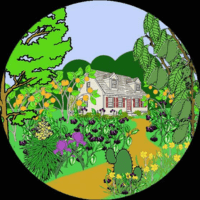Che (Mandarin Melon Berry, Silkworm Thorn)
Che is the BEST uncommon fruit tree. However, there’s a LOT of mix information about it. Thankfully, growing it could not be easier.
The Che tree is also called the Cudrang, Mandarin Melon Berry, Silkworm Thorn and many other names. Also, its Latin (species) name changed from Cudrania tricuspidata to Maclura tricuspidata.
The Che tree originates from China. It was introduced to America 100 years ago! A brief history is below. Che fruit is soft and tastes like cantaloup-watermelon! The tree has beautiful leaves, is drought-tolerant, and grows to a modest size. However, there’s a lot of contradictory information online. That’s why I address four important topics. The four topics will to help YOU select the right tree, and clarifies inconsistent information. We grow superb, thornless trees that produce great fruit.
Like the Mulberry, Che trees are as easy to grow as it gets. Also, it’s a pleasure to eat ripe fruit right off the tree. Unlike the Mulberry, the Che does not get as large and is entirely disease and pest free. Tree care and maintenance is straight-forward.
Maclura tricuspidata fruit has antioxidant properties. Even better, the study cites that anticancer, anti-inflammatory, antioxidant, anti-obesity, and anti-diabetes properties have been reported over the last two decades!
We grow four varieties of Che. Three varieties are excellent and one is not recommended. There’s a fifth tree on our Wish List! Below is all the information you need to grow a fantastic fruit tree!
________________________________________
see our list of 400 edible plants
YouTube channel (please subscribe)
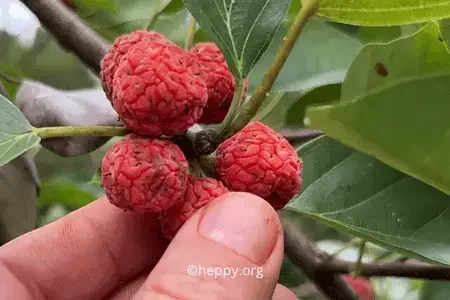
As an Amazon Associate, HEPPY earns from qualifying purchases (paid link).
Here’s a list of all the products we truly use and trust.
Che Tree Fact Sheet
Common Names for Che, Maclura tricuspidata (syn. Cudrania tricuspidata)
Common names in English are Cudrang, Chinese Melonberry, Chinese Mulberry, Mandarin Melonberry, Mandarin Melon Berry, Seedless Che, Silkworm Thorn, and Storehousebush.
Common names in Chinese are Tcho Sang (Wild Mulberry), Tsa, Tse-tsang (Thorny Mulberry), Cha-shu, Poh-hsi, Shih, Nu-che, and Zhè (Che).
Fact Sheet
Zone: 6-9 (possibly zone 5)
Height: 12 – 20 feet (depends on the cultivar and grafting)
Native: China
Bloom Time: April-May (blooms are not noticeable)
Bloom Color: yellowish-green (blooms are not noticeable)
Fruit Maturity: August – October
Self-fertile: yes (some cultivars)
Sun: full sun
Water: medium (mature trees tolerate drought)
Soil: adaptable (wide range)
Maintenance: little
Growth Rate: fast
Deciduous or evergreen: deciduous
Edible¹: yes (discussed below)
Medicinal²: yes (discussed below)
Commercial viability: low (largely an unknown tree, fruit, etc.)
Family / Genus: Moraceae / Maclura
Remarks: Che is 100% pest/disease free; varieties we grow are thornless (some ARE thorny).
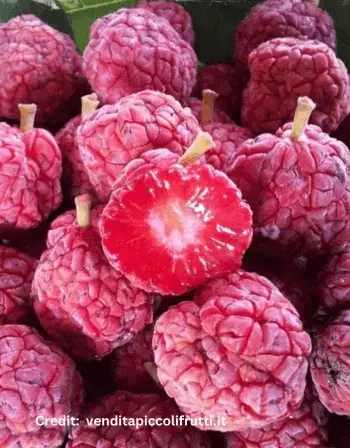
History of the Che Tree
The Che is native to China. The Chinese valued the tree’s leaves as food for silkworms. It was either a substitute for Mulberry leaves or simply and alternative. However, according to Dr. Lee Reich, the Che fruit itself is rarely mentioned in writings from China.
France and England began growing the Che by 1860s-1870s. Then, it arrived in America in 1909. By 1912, a tree at P. J. Berckman’s Nursery in Augusta, Georgia was twelve feet high and bearing a bushel and a half of fruit. The US Department of Agriculture tested the Che as a hedge plant in drier regions, and for bank stabilization elsewhere. However, as of today the Che remains largely unknown (Che: Chewy Dollops of Maroon Sweetness, by Dr. Lee Reich.)
So why hasn’t the Che tree “taken root” commercially or among gardeners? I’m not sure. Post 1912, there’s scant evidence of Americans knowing of, or planting the tree. Nurseryman Cliff England grows the Norris TVA Che tree. He found the tree around the Norris Dam Project in northern Tennessee. I suspect that the Che tree is from the Tennessee Valley Authority (TVA) tree improvement study that started in 1933. The TVA established an experimental tree crop nursery at Norris Dam (Clemens M. Kaufman, School of Forestry University of Florida). The possible goal was to develop tree crop agriculture on hilly lands (Carl L. Hawkes, 1958). The TVA new of the Che and Cliff England cultivated it. Then … crickets.
From 1912 to 1933 to the present, FEW commercial enterprises have cultivated the Che. Consequently, few people know of it, or grow it. In fact, only a few dedicated nurserymen and gardeners have kept the Che’s history in America.
Final thought: oddly, the Chinese culture was active in cultivating fruiting plants. If the native Che tree was thorny or grew undesirable fruit, then why wasn’t it cultivated to be desirable? Virtually every fruiting tree sold is derived from long history of cultivation. I have no good answer. The Che sold in America by select-few nurseries is a wonderful fruiting tree.

As an Amazon Associate, HEPPY earns from qualifying purchases (paid link).
4 Topics about Maclura tricuspidata (syn. Cudrania tricuspidata)
Online are many topics about the Che with conflicting information. Below, I address 4 topics based on my experience buying and growing four varieties of Che trees. I also read volumes of credible posts and authors’ writings.
Bottomline: the safest purchase is Che tree sold as, “seedless che” or “seedless female.” The Seedless Che from Edible Landscaping is the standard. Edible Landscaping and other nurseries offer it. The key words are, “seedless che” or “seedless female.” Secondarily, a Norris (Norris TVA), California Dreaming, and ‘Darrow’ seedless female are varieties that I also recommend. (For disclosure, I make NO commission from the latter).
Three KEY questions to ask before buying a Che tree:
- is it a self-fertile female tree? You want a self-fertile female tree.
- will it develop long thorns or, a only few thorns (if any) when the tree is young? You want a tree with no thorns, or a few thorns when young.
- is it grafted onto Osage Orange; that, the Che tree will not sucker? You do not want a suckering Che tree IF you’re a gardener like me.
Topic 1: Seedless Che fruit vs. fruit with seeds?
There is LITTLE clarity on this topic. However, I cite two excellent sources for understanding this topic.
At issue are the many contradictory comments about Che fruit with seeds and male trees.
Bottomline is that you WILL have a few seeds in each Che fruit if a male tree is in the vicinity of a female Che tree. However, I recommend avoiding male Che trees altogether! Male trees provide very LITTLE fruit if any. Also, if the male tree is not grafted to Osage Orange, you’ll have suckers of a tree that does not bear fruit!
California Rare Fruit Growers
The Che is dioecious (trees are male or female). Flowers appear in June. Both male and female trees have green and pea-sized flowers. Male flowers turn yellow as the pollen ripens and is released. Male plants occasionally have a few female flowers which will set fruit. California Rare Fruit Growers.
Dr. Lee Reich
Che flowers are hard to pin down morphologically. Che trees are either male or female (dioecious), but male trees frequently bear some fruits (which only follow female flowers) and female trees frequently yield good crops without male pollinators.
Male or female Che trees might bear flowers of the opposite sex. Those flowers may be few or on whole branches. “This explanation seems more likely than parthenocarpy because ripened fruits typically have a few seeds in them, which indicates that pollination did occur — unless Che is among the few plants capable of producing seeds solely from mother plant tissue, without pollination (i.e., it is apomictic).” Chewy Dollops of Maroon Sweetness, by Dr. Lee Reich.
To sum up Seedless Che fruit vs fruit with seeds: this topic is overly technical for the average gardener. Perhaps, it’s an important topic for commercial operations. Overall, I’m standing by my recommendations above!
Topic 2: Thornless Che trees vs. with thorns?
Why is my Seedless Che without thorns and the Hwang Kim #3 a near-death experience? Well, it’s because I didn’t know or didn’t listen.
At issue is the wide range — the variability — of thorniness of Che trees. Some Che trees produce thorns that are truly hazardous while other varieties do not!
Bottomline is that we grow four varieties of Che trees. Only one variety, the Hwang Kim #3 has thorns. However, its thorns are so long and ridged that the tree is virtually dangerous. Further, the Hwang Kim #3 grows the most vigorously. Therefore, pruning is required annually and disposing of the many trimmed branches is hazardous.
Dr. Lee Reich
“Che’s thorns are an unresolved issue….Cytological studies and observation of seedling plants as they mature would resolve this issue.” Chewy Dollops of Maroon Sweetness, by Dr. Lee Reich.
To sum up Che trees with thorns vs. without thorns: in the worse-case scenario you may have small, juvenile thorns on only young trees. However, thorns will disappear as the tree matures. Or, you may see virtually no thorns. Candidly, I don’t remember seeing thorns on three of the four varieties we grow. That’s why I’m standing by my recommendations above!
Topic 3: Suckers vs. trees grafted onto Osage Orange?
California Rare Fruit Growers has no information about suckering. Dr. Lee Reich writes only that, “Some suckers are produced at the base of the plant….”
At issue is conflicting information online. Some report intense suckering.
Bottomline is that we grow four varieties of Che trees. Not one suckers and all are grafted to Osage Orange, Maclura pomifera rootstock.
Just Fruits and Exotics
Plants started on their own roots or grown from seed can be a shrubby suckering mess in the garden, and are often very thorny. By grafting the melon berry onto an Osage orange a superior single-trunk fruit tree is created. Mandarin Melonberry Cudrania Tricuspidata A Truly Uncommon Fruit.
To sum up Suckers vs trees grafted onto Osage Orange: it’s likely that Che trees NOT grafted to Osage Orange rootstock may, or do, sucker. The tree’s natural, native tendency is to sucker. That is why I’m standing by my recommendations above!
Topic 4: Che fruit is flavorful vs. little flavor (or, no flavor)?
This topic bother me because when Maria and I devour this fruit. We discovered its ripe fruit while visiting Edible Landscaping in September. (Edible Landscaping has a ~20 year-old tree on it’s property.) Trust that Maria and I do NOT devour fruit with no flavor, as is sometime reported online.
At issue are the many contradictory comments about Che fruit’s flavor. “Ripe che has very little flavor” according to one writer.
Bottomline is that Che fruit has a WONDERFUL, fruity flavor. However, it is true that unripe fruit is tasteless (as with all fruit).
California Rare Fruit Growers
The flavor is quite unlike the vinous quality of better mulberries … when fully soft ripe they develop a watermelon-like flavor that can be quite delicious. The sugar content is similar to that of a ripe fig. California Rare Fruit Growers.
Dr. Lee Reich
The flavor is most definitely fresh fig plus mulberry although neither quite as rich as the fig nor quite as sweet as the mulberry. Chewy Dollops of Maroon Sweetness, by Dr. Lee Reich.
To sum up Che fruit is flavorful vs. very little flavor: Che fruit tastes like a mix between watermelon and cantaloupe. Give a red fruit a squeeze and if soft, pick it and enjoy! The softer the better! The flesh is lush but not wet (like plum). However, perhaps different varieties (cultivars) have varied flavor. Further, is is wholly unclear why statements like, “unripe fruit has no taste” matters.
Overall, I’m standing by my recommendations above!
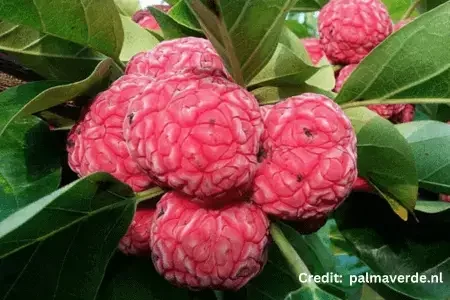
Eating Che fruit and recipes
1, 2 HEPPY cannot take any responsibility for any adverse effects from the use of plants. Always seek advice from a professional before using a plant for food or medicinally. This information is
Picking ripe Che fruit
Give a deep-red fruit a squeeze and if it’s soft, then pick it and enjoy! Deep-red colored fruit will be soft.
Ripe Che fruit tastes like a mix of watermelon and cantaloupe. I often read references to fig. I’d say the texture is similar. The flesh is lush like fig. It’s not a ‘wet’ fruit like tree-ripened plum.
Why isn’t Che fruit in the store?
Ripe Che fruit does not transport well. You’d have to pick and process Che like Blueberry, Blackberry, Raspberry, etc. It’s labor intensive at scale. Also, the self-life of fresh Che fruit is short (like Blueberry, Blackberry, etc.). So it’s not the best in-store product. Finally, the fruit is not well known by consumers. So farmers won’t grow it. Che is like an “exotic” fruit. It’s an unusual or rare fruit that’s NOT unusual. They are a fruit not found in grocery stores.
Recipes
In Korea, premature and fully mature fruits are used to make fresh juice, jam, wine, vinegar, and fermented alcoholic beverages. I suspect that Che fruit could be used to make jam, ice cream, smoothies and more. Also, adding the fruit to a salad would give color, and a fun texture.
The North American Raspberry & Blackberry Association has AD-FREE recipes for jams, jelly, syrups, preserves, sherbet, pie, parfait, smoothies, tarts, muffins, and more. Please provide feedback — what recipe would work?!
Growables, Inc. has an line recipe for Sweet-Hot Che Jam. Give it a try!
Che Tree Health Benefits
1, 2 HEPPY cannot take any responsibility for any adverse effects from the use of plants. Always seek advice from a professional before using a plant for food or medicinally. This information is
Maclura tricuspidata (formerly known as Cudrania tricuspidata) have been used in traditional Korean herbal medicine. The leaves, root, stem, and fruit have been used to treat jaundice, hepatitis, neuritis, and inflammation.
The same study writes, “Over the last two decades, several beneficial effects of M. tricuspidata extracts have been reported; they include anticancer [2,3], anti-inflammatory [4], antioxidant [5,6], oxidative stress-induced neurotoxicity [7], anti-obesity and anti-diabetes properties [8]. Moreover, a variety of bioactive compounds such as prenylated xanthones, phenolic acids, and flavonoids have already been identified from its leaves, root, stem, and fruit [9,10,11]. These compounds were also reported to have antitumor [11], antibacterial [12], antioxidant [13,14], neuroprotective [1], cytotoxic [13,15], anti-inflammatory [16], hepatoprotective [17], gastroprotective [16], and α-glucosidase inhibition activities [18].” Interestingly, the study concluded that favorable antioxidant activities were higher in immature fruit than at fully mature fruit. (Comparison of Bioactive Compounds and Antioxidant Activities of Maclura tricuspidata Fruit Extracts at Different Maturity Stages.)
We could delve further into that ONE study for weeks. Particularly, the anticancer, anti-inflammatory, antioxidant, anti-obesity, and anti-diabetes properties.
Volunteer at HEPPY to find more at NIH PubMed. There’s a lot more to learn about the health benefits of Che fruit!
Che tree care and maintenance
Maclura tricuspidata is related to the Fig and Mulberry (the Moraceae family). Overall, the Che is easier to care for than latter two.
Sunny and well-draining soil is optimal. However, Che trees are adaptable to many soils. They are entirely drought tolerant once established. Pruning is similar to the Mulberry but of less work. Maclura tricuspidata are easy to care and maintain!
Sunlight
Maclura tricuspidata thrive in hot, full sun. Full sun assures a healthy tree and the most fruit.
Soil
Che trees tolerate almost any soil, and will grow in nutritionally poor soil. However, it will not be healthy, will take longer to begin fruiting. Also, trees planted in poor soil typically need more watering.
The preferred soil is well-draining and organic. Straw, leaves or woodchips are free, and ideal soil amendments.
Watering
Maclura tricuspidata are drought tolerant once established. A Che tree is well established by the second or third year IF planted in well-amended soil.
Watering young or newly planted trees
Regularly water young trees (once / twice weekly, when it’s not raining). Water newly planted trees more frequently until established (2 months minimum).
Water well during the warm months. However, there’s no reason to water overwinter when the tree is dormant.
Watering depends on your soil
Is the soil well-amended with decayed woodchips or compost? Then a LOT LESS water is needed.
Pruning
Prune established Che trees to maintain shape. Prune up to 50% of new growth. They respond well to pruning.
Maclura tricuspidata can grow sideways as well as upward. Therefore, be mindful of promoting a single-trunk, if a single-trunked tree is desired. I used several stakes, for several years, to grow our Seedless Che in a vertical direction.
Low-to-the-ground limbs will “meander” sideways and even downward. It’s important to create a structured tree while it’s young.
As an Amazon Associate, HEPPY earns from qualifying purchases (paid link).
Che tree we grow organically
Che trees we grow and some to consider
- Seedless Che from Edible Landscaping
- Norris (TVA Norris)
- California Dreaming
- Hwang Kum #3 (I recommend NOT growing)
- Darrow Seedless Female (on our Wish List; you should consider it too)
________________________________________
see our list of 400 edible plants
YouTube channel (please subscribe)
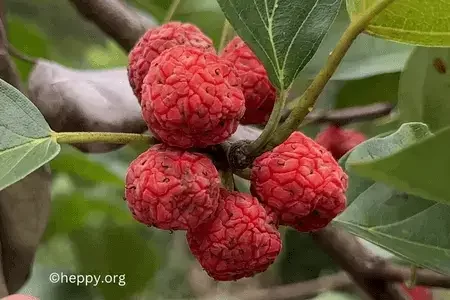
1. Seedless Che from Edible Landscaping
The Edible Landscaping Seedless Che is our favorite Che tree (Edible Landscaping Nursery). It’s completely self fertile and seedless. The Seedless Che grows to 15′ at best. The tree’s crown is rounded. I sincerely do not remember seeing a single thorn on this tree. Also, there’s no suckering.
Our Seedless Che was purchased from Edible Landscaping. It was their last tree (they are always grafting and cultivating more). However, as the last tree it had a “crook” in it’s trunk and was very small. Maybe 16″ tall. It was in a 3/4 gallon pot and sold for $30.00 (2017).
She grew fast and showed fruit by 2019 had a few fruit. However, true t the tree’s nature, fruit fell off before maturity. Small crop in 2021, more in 2022 and loaded in 2023. Keep in mind that planting a 16″ tall fruiting “tree” means … it’ll several years to have abundant fruit. After that, LOOK OUT because she fruit’s abundantly and plentifully!
I can ASSURE that Edible Landscaping’s Seedless Che is seedless, thornless, has no suckering, and the fruit is excellent. I suspect that the TVA Norris and Darrow are also quality Che trees. However, unlike Edible Landscaping’s Seedless Che, I’ve not seen or eaten fruit from the Norris and Darrow.

2. Norris (TVA Norris) Che tree
This cultivar was discovered by nurseryman Cliff England (England’s Orchard and Nursery). He found it in/around the TVA’s Norris Dam project. More is discussed above in the History of Che Tree.
Cliff England will soon receive a long list of questions from me about Che trees and this cultivar. Candidly, I’m more fascinated by the tree’s history and Cliff’s knowledge of the location.
It’s described as a “self-fruiting tree …. [derived from a massive tree] well over 80 years old …. fruit size is about the size of a nickel. It is a good producer. Has seedless fruit if a male is not present. Expect trees to produce in the 2 to 3 seasons after planting.”
Our TVA Norris is still in a pot. Che trees do very well in pots. I looked-up the buy date: 2018. She’s been in a pot from 2018-2023. That’s embarrassing and, proof that Che trees do great in pots. However, my goal is to plant her in 2024.
Other small businesses selling the Norris include Cricket Hill Garden and Just Fruits and Exotics.
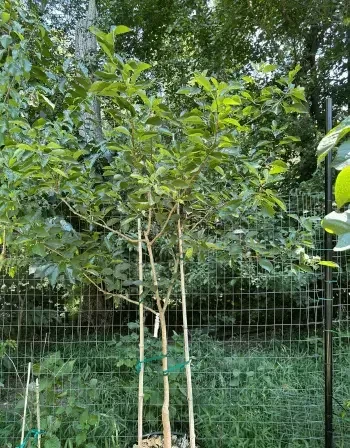
3. California Dreaming Che tree
England’s Orchard and Nursery sells the California Dreaming Che tree. I forgot it’s origin. Nurseryman Cliff England will soon receive a long list of questions from me about Che trees and this cultivar.
Cliff describes it as, “Larger than most and more productive with upright growth habits, berries are sweeter does not produce seed, but the fruit is larger if a male is present as all Che will produce seed if pollinated.” Remember, altogether avoiding a male Che tree is my advice (1 of the 4 topics discussed above).
In 2020 we purchased the California Dreaming Che tree as a bare root. It was only $28.00! She was in a pot for several years. Che trees do very well in pots. Finally, she was planted in Spring 2023.
It seems to grow more upright. However, as we do at HEPPY™, we prune her to encourage lateral growth. Therefore, limbs growing straight-up are pruned. We want to pick fruit from right over our heads! In a pot or in her spot, she’s growing fantastic. As of Sept 2023, one fruit hung-on. That is indicative of Maclura tricuspidata (syn. Cudrania tricuspidata). They take several years before bearing a good crop.
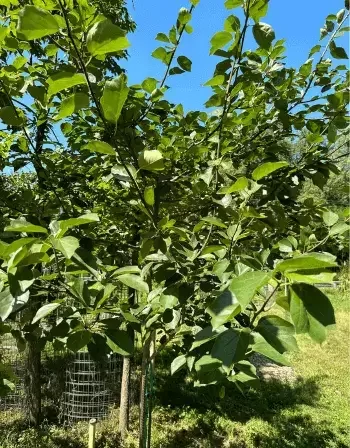
4. Hwang Kum #3 Che tree
One word: AVOID. I’ll kick Cliff when I see him or, I have a turd Che-tree and don’t know it. This tree has thorns from hell.
Let me back-up and explain something about thorns. Fruiting plants like the Goumi, Goji Berry and some native plums have “thorns.” However, I don’t use gloves when pruning or picking fruit from them. When I say thorns I mean, hell-thorns. Gloves and a long-sleeve shirt are marginally sufficient when pruning the Hwang Kum #3 Che tree (that we have). I’m giving this tree a hard “no” — avoid it.
It grows fast. And to this day, we’re attempting to grow her as a single trunk (you may see a 2×4 in the pic to the right). It wants to be a 30′ wide bush! A 30′ wide bush with thorns from hell! No fruit of value. Heck, it may be a male. I will be watching this tree like a hawk this spring, 2024.
In the picture to the right you see ONE-YEAR’S growth growing from its crown. EACH branch is 12 feet or longer!
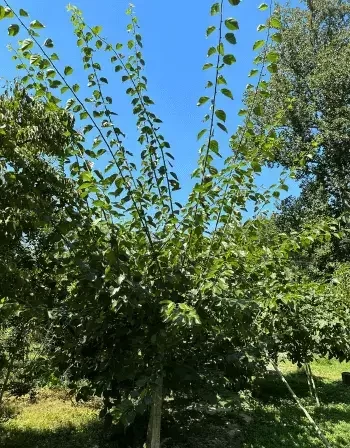
Hwang Kum #3 isn’t the only Hwang Kum Che tree. There are numbers 1 through 4 (Hwang Kum #1, etc.). It’s my understanding that numbers 1 through 4 have to do with ripening. Hwang Kum #1 ripen first and Hwang Kum #4 ripens last. Fun fact but avoid the tree!
5. Darrow Seedless Female Che tree
The Darrow Che is sold by Cricket Hill Garden. It’s advertised as, “Self-fertile seedless female trees bear a prolific crop of maroon-red, 1-2″ fruit. Ripe fruit have a sweet flavor which is often compared to that of a fig with notes of watermelon.”
We do not grow the Darrow … yet. It’s on HEPPY’s Wish List. Two things about this tree stood-out: “seedless female” and Darrow.
Reason 1: Seedless female! I recommend avoiding a male Che tree. Buying a seedless female is my advice! Above, I give advice on four key topics.
Reason 2: Dr. George McMillan Darrow. This gentleman was amazing. He was a pomologist — someone who studies and cultivates fruit. His has a long rich history of contributions to America (and perhaps, the world). Any Che tree named after him must be at HEPPY!
Other small businesses selling the Darrow include England’s Orchard and Nursery and Just Fruits and Exotics.
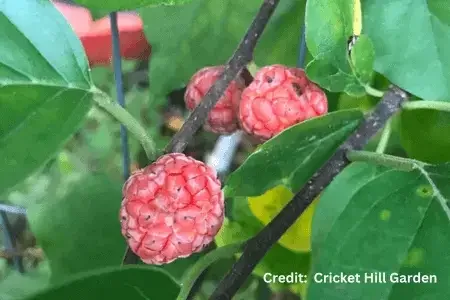
Varieties of Che tree, Maclura tricuspidata (syn. Cudrania tricuspidata)
I’ll dive deeper into these varieties. Some may be male or females, while others are exclusively male or exclusively female.
All Che Trees
- Adam Barr (or, Adams)
- Chul Ri
- Daniecki
- Darren Bender
- Darrow
- David’s
- Edible Landscaping
- Hwang Kim #1
- Hwang Kim #2
- Hwang Kim #3
- Hwang Kim #4
- Stevenson
Females
- Darrow
- Edible Landscaping
Males
- Daniecki

